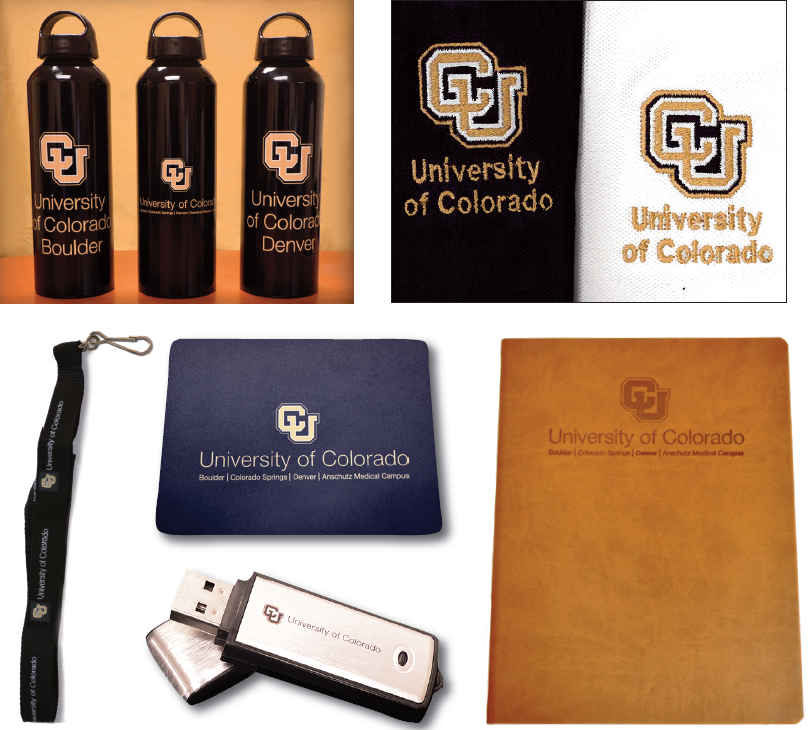CU Branding and Identity Standards Manual
Introduction
From the President,
The University of Colorado is many things to many people. The common thread for all our constituents is that we are a world-class teaching and research university advancing the economic, social and cultural health of Colorado and beyond.
The collective strength of the University of Colorado has been built over the past 135 years. It is critical that we use the equity we’ve created to promote CU in ways that cut through the clutter of images and messages pervasive in communications today. Doing so demands that we present consistent, coordinated messages and visual images to our key stakeholders.
The university continually competes for resources, attention and students. We cannot afford to hinder our efforts in that competition by presenting mixed messages, confusing images or a fragmented view of the university.
This Identity Standards manual serves as a roadmap for effectively conveying who we are, what we do and why our efforts are valuable. Its intent is to not only serve as a guide for effectively presenting the university, but also to make the best use of resources.
Presenting the university through consistent and coordinated messages and images will allow us to better showcase our excellence, value and impact. It will also lead to better connections with key audiences and convey our strengths in learning and teaching, discovery and innovation, health and wellness, and community and culture.
Every member of the university community has a role in advancing our efforts. Using these standards will help us do so in coordinated and consistent ways.
Branding Position
Our brand is a promise we make about all things related to the University of Colorado (CU): our campuses, our foundation and our system. Our brand is more than a name or a logo. Every point of contact we have with our audiences— students, faculty, staff, alumni, donors and others—builds perception about who we are as a university, the things we do to fulfill our mission and why we are important to our stakeholders.
Who we are, what we do and why it matters
For centuries, people have been drawn to Colorado for discovery, individual success and better lives. We are the University of Colorado, and we embody that spirit by investing in the people, places and ideas that will move Colorado and the nation successfully into the future.
We are a recognized leader in higher education on the national and global stage. We collaborate to meet the diverse needs of our students, faculty, staff and communities. Our purpose is to promote innovation, encourage discovery and support the extension of knowledge in ways unique to the state of Colorado.
The University of Colorado advances the economy, culture and health of Colorado and the nation.
Brand attributes
The personality and character of our brand
We are committed to the improvement of higher education in the state of Colorado.
We partner with other institutions, our communities and among ourselves to advance the educational and health needs of the state and our constituents.
We support discovery and create possibilities so people, places and ideas can thrive.
We draw from the environment and the people around us to keep our thinking fresh and meaningful.
We are pragmatic and honest about the challenges facing us today and the solutions we will employ tomorrow.
Core messages
How we communicate in support of our position, organized under four areas of excellence and impact
- We are a leader in higher education for the state, providing the broadest range of educational opportunities.
- We provide a distinctive balance of traditional and experiential learning that supports a broad range of faculty and student endeavors.
- Our research directly benefits Colorado, from health care advancement to technology innovation.
- We cultivate people and ideas to create value for the state of Colorado.
- We are an essential part of the fabric of communities across Colorado.
- We play a significant role in sustaining economic social and cultural vitality in the state, and we extend our reach to a national and global stage.
- We drive health care innovation, delivery and education for Colorado and beyond.
- We improve health by treating and curing disease through research and innovation.
University Brand Identity Standards Board
The University Brand Identity Standards Board comprises representatives with professional expertise in branding, marketing and communications from each campus, system administration and the CU Foundation. It is the responsibility of this board to maintain the standards of the University of Colorado brand as authorized by the Board of Regents and directed by the president.
Each campus has its own brand standards board, responsible for maintaining the brand standards specific to the campus. The campus boards provide advice and guidance on issues specific to campuses, but do not approve exceptions or deviations from the campus or system guidelines.
The development or use of independent logos, graphics or word marks by CU entities that deviate from the guidelines detailed in these standards is not consistent with university trademark policy and is strictly prohibited without written approval from the University Brand Identity Standards Board, campus chancellor or CU president.
Contacts for the University Brand Identity Standards Board
SYSTEM ADMINISTRATION
Elizabeth Collins
Executive Director
University Relations
303-860-5624
elizabeth.collins@cu.edu
BOULDER
Jon Leslie
Executive Director of Marketing and Creative Services/Administration
University Communications
303-492-2531
jon.leslie@colorado.edu
COLORADO SPRINGS
Martin Wood
Vice Chancellor, University Advancement, and Managing Director, National Institute for Science, Space and Studies
719-255-3438
mwood@uccs.edu
DENVER
Karen Klimczak
Assistant Vice Chancellor
University Communications
303-315-2153
karen.klimczak@ucdenver.edu
UNIVERSITY OF COLORADO
ANSCHUTZ MEDICAL CAMPUS
Jenny Merchant
Creative Brand Manager
303 724 2515
Jennifer.merchant@cuanschutz.edu
University Seals
OFFICIAL SEAL
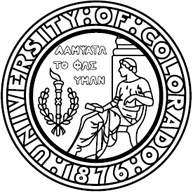
The official university seal (with Greek lettering as part of the interior design) lends authenticity to documents that emanate from the university, particularly in its corporate capacity. It is used primarily on diplomas, official transcripts, written agreements and contracts and certification of Board of Regents actions. It is also used on the president’s chain of office, the university mace, commencement programs, regent regalia and print and electronic publications of the Board of Regents.
The offices of admissions and records on each campus are authorized to use the official seal on documents requiring authentication and containing information drawn from official records of the university.
Use of the official seal for purposes other than those described above is prohibited. The secretary of the university and Board of Regents is the custodian of the official seal and maintains discretion as to its use.
COMMERCIAL SEAL
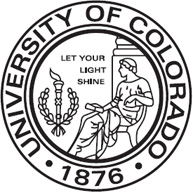
The commercial seal (English lettering as part of the interior design) has limited application and should not be substituted for approved university marks on business collateral (stationery, envelopes, etc.), web pages, electronic applications, print pieces, signage, vehicles or apparel. Its use is reserved for approved signage and podiums.
Members of the university community have the option of using it on business cards and laboratory coats for physicians and researchers. Any other uses must be approved by the University of Colorado Brand Identity Standards Board.
Systemwide brand architecture
The goal of our brand architecture is to support a strong University of Colorado visual identity with strong campus identities.
The University of Colorado seal and signatures provide for consistency, coordination and synergy in how we represent ourselves. Every communication we create is an opportunity to tell our audiences who we are as a university, the unique things we do to fulfill our mission and why we are important to our stakeholders. One of these signatures should appear on all materials.
The official seal of the University of Colorado is used on official university documents such as diplomas, decrees and official transcripts. Use of the official seal rests with the secretary of the university and the Board of Regents.
The University of Colorado system signature is used by the president’s office.
Each campus uses its own signature. The architecture specifies how the campus identities relate to one another and provides a structure for the creation of new campus signatures in the future.
Additional details are available in the brand identity standards for each campus.
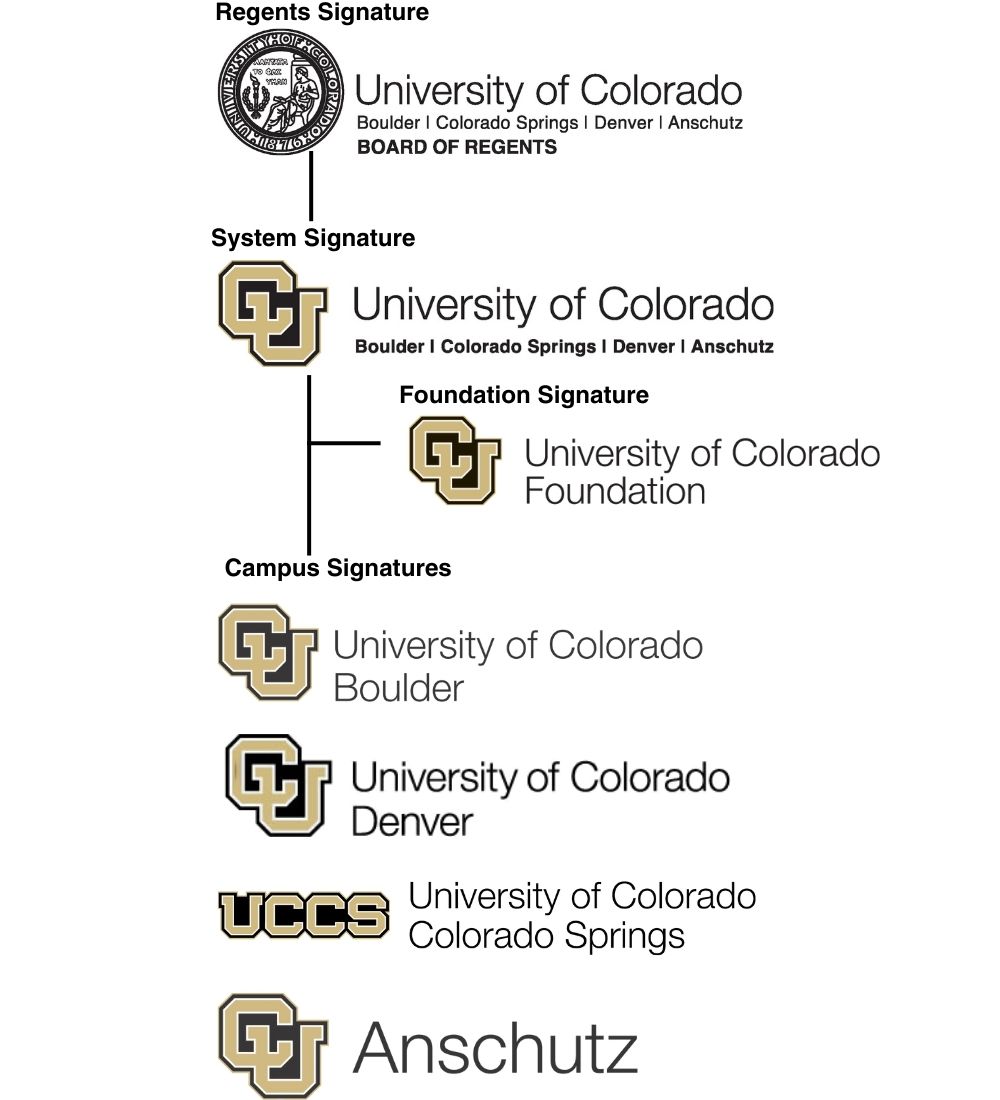
Signature variations and extensions
Each campus can choose from five approved variations of their official signatures, as illustrated by the examples below.
Additional details are available in the brand identity standards for each campus.
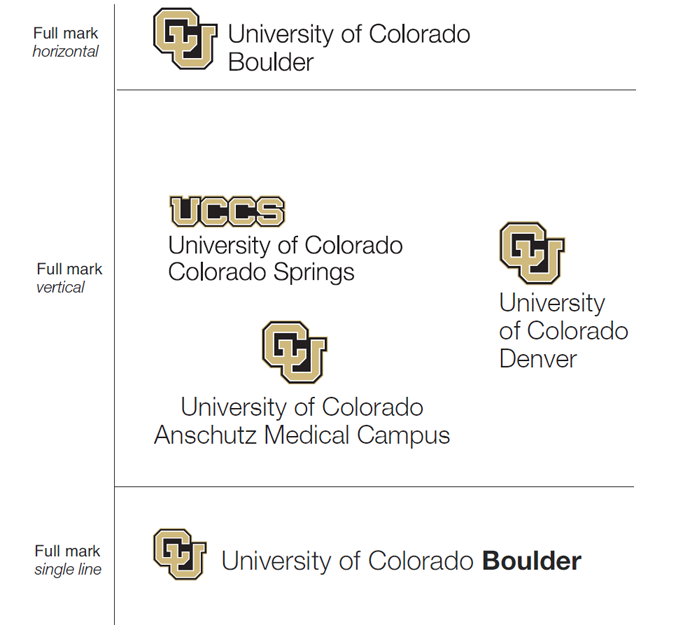
Signature variations
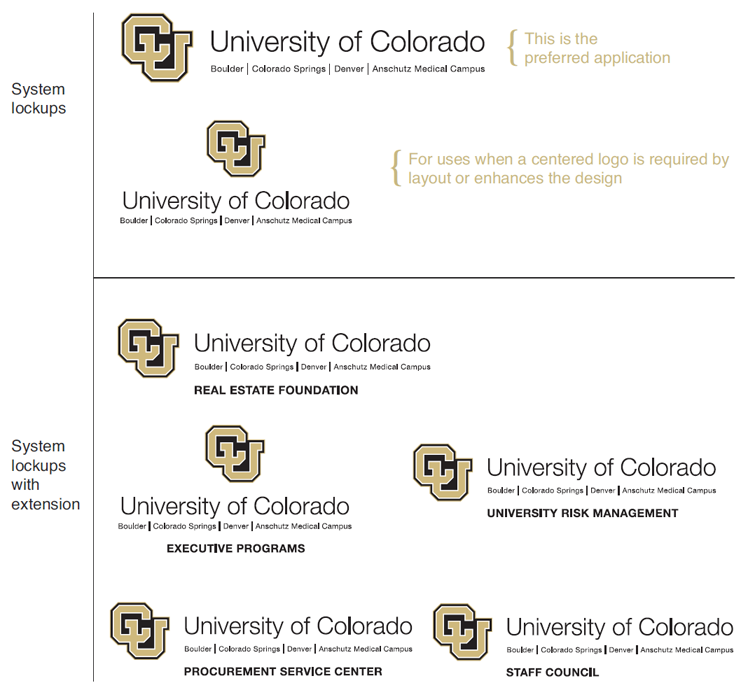
Ancillary marks
Subidentities
The brand equity for units, schools and colleges rests with their affiliation with the University of Colorado and its campuses. Subidentities (including logos, wordmarks, typefaces and alternate design elements other than those officially approved) detract from the university’s ability to project a consistent, coordinated identity. Therefore, logos, wordmarks and alternate identities that deviate from the approved identity standards detailed in this manual and/or campus manuals are prohibited.
Donor-named schools or colleges
Schools or colleges that have received contributions that allow naming of the school or college for the donor (as approved by the CU Foundation and Board of Regents) shall have the opportunity to use a distinctive typeface as part of the signature line, but not a logo that deviates from approved identity standards.
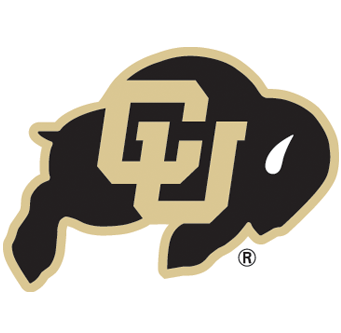


Intercollegiate athletics marks
Athletics marks (“Ralphie” and the athletics interlocking CU at CUBoulder; Milo at CU-Denver; Mountain Lion at UCCS) are exclusive to the Departments of Intercollegiate Athletics. These marks should not be used by units, departments, schools, colleges or affiliates. Any use other than for intercollegiate athletics and/or approved vendors must have written permission from the Campus Brand Identity Standards Board. Guidelines for the use of Ralphie can be found at http://brand.colorado.edu/downloads. The marks are trademarked and governed by the University Licensing Office.
Exceptions to identity standards
Any exceptions or deviations to the University of Colorado Identity Standards must be approved by the University of Colorado Brand Identity Standards Board, as authorized by the Board of Regents and directed by the president. Complementary campus Brand Identity Standards Boards (and campus Identity Standards documents) provide advice and guidance on issues specific to campuses, but do not approve exceptions or deviations from campus or system guidelines.
Co-branding
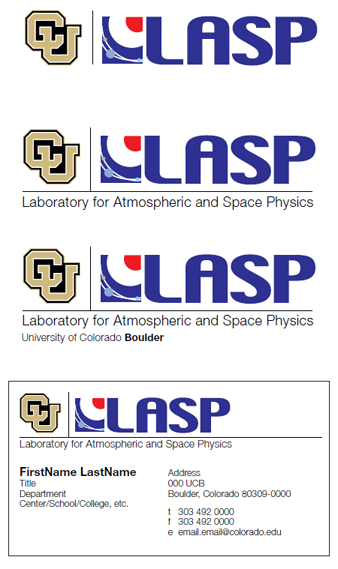
A. General guidelines for co-branded logos:
A small number of entities at the university operate under the auspices of, or in conjunction with, external entities such as agencies of the federal government. Those that do may use the external entity’s logo in
conjunction with the university logo, as approved by the University Brand Identity Standards Board.
- Approved co-branded logos may only be employed by those groups that meet requirements and have received approval from the University Brand Identity Standards Board and the CU president.
- Approved co-branded logos may be used for marketing, communications and promotional purposes.
- Approved co-branded logos can be used with or without an accompanying wordmark identifying the entity.
- Approved co-branded logos may be used on university business cards or letterhead.
- In all other aspects, co-branded logos follow the same usage guidelines as standard university logo signatures.
The following eligibility requirements detail what units may be able to receive a co-branded status:
- Entity must to have a permanent contractual connection establishing them as a joint entity between the university and an outside entity or be a university institute that has been approved by the Board of Regents.
- Entity must detail why the inclusion or utilization of a custom logo or mark will benefit their business objectives more than using the standard CU identity system.
- Entity must receive a recommendation from its chancellor.
- The University Brand Identity Standards Board must approve a co-branding exemption.

B. Transitional use of a unit-specific brand identity (custom logo) in conjunction with the university logo:
A small number of university entities (e.g., arts organizations or other cultural attractions) may qualify for transitional use of an existing logo identity where existing brand equity is directly tied to revenue streams. To request transitional use of an existing logo identity, university entities should contact their campus brand identity representatives. Each request will be forwarded to the University Brand Identity Standards Board for review and approval. In each case a period of transition will be identified, during which time the entity may use their existing logo identity in conjunction with their correct campus logo ID.
C. Use of university logos in conjunction with a third-party logo:
In select instances (e.g., event sponsorships, joint initiatives, special events, etc.) a university logo may be used on materials that also feature external third-party logos. In these instances, the university logo must be placed with a minimum clear space on all four sides equal to the width of the interlocking CU (or UCCS graphic) as placed. A university logo may not be COMBINED with an external third-party logo under any circumstances (other than a permanent contractual connection as described in Section A). The interlocking CU may not be used as a standalone element.
NOTE: For university events, the university logo should not appear mixed in with other sponsorship logos, but rather be treated separately. If the logo must appear beside other sponsor logos, it must appear first
and be at least twice the size of the other sponsors.
University of Colorado signature
Always use the original artwork; never recreate or reposition the elements. For artwork, please contact the university brand manager.
Color variations
There are five different color variations: full-color, grayscale, one-color (black), reverse (gold) and reverse (white).
Clear space
Clear space is measured by the height of the U in the wordmark.
Minimum size
The wordmark cannot be smaller than 2 inches wide.

University of Colorado Foundation signature
Always use the original artwork; never recreate or reposition the elements. For artwork, please contact the university brand manager.
The campuses must always be included when using the University of Colorado signature.
The interlocking CU must not be used as a stand-alone logo.
Color variations
There are five different color variations: full-color, grayscale, one-color (black), reverse (gold) and reverse (white).
Clear space
Clear space is measured by the height of the U in the wordmark.
Minimum size
The wordmark cannot be smaller than 1 inch wide.

University of Colorado Boulder signature
The CU Boulder signature includes two elements: the logomark and the wordmark.
Always use the original artwork; never recreate or reposition the elements. For artwork, please contact the campus brand manager.
Color variations
There are five different color variations: full-color, grayscale, one-color (black), reverse (gold) and reverse (white).
Clear space
Clear space is measured by the height of the U in the wordmark.
Minimum size
The wordmark cannot be smaller than 1 inch wide.

University of Colorado Colorado Springs signature
The UCCS signature includes two elements:
the logomark and the wordmark.
Always use the original artwork; never recreate or reposition the elements. For artwork, please contact the campus brand manager.
Color variations
There are five different color variations: full-color, grayscale, one-color (black), reverse (color) and reverse (white).
Clear space
Clear space is measured by the height of the U in the wordmark.
Minimum size
The wordmark cannot be smaller than 1 inch wide.
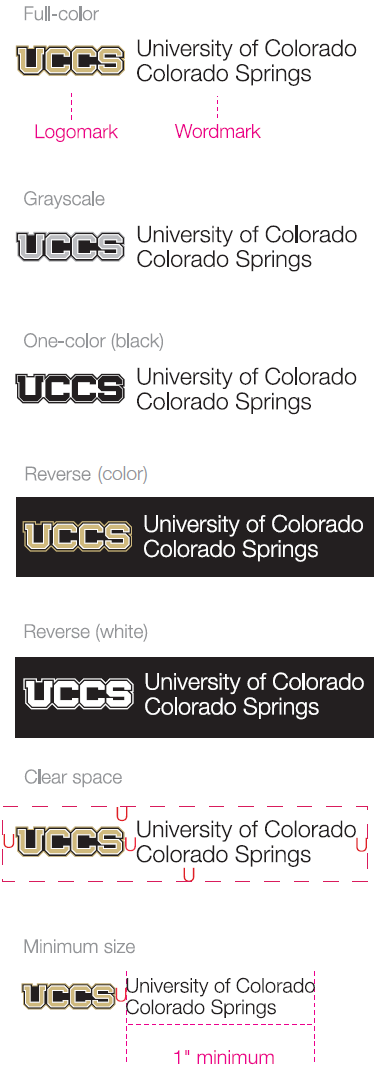
University of Colorado Denver signature
The CU Denver signature includes two elements:
the logomark and the wordmark.
Always use the original artwork; never recreate or reposition the elements. For artwork, please contact the campus brand manager.
Color variations
There are five different color variations: full-color, grayscale, one-color (black), reverse (gold) and reverse (white).
Clear space
Clear space is measured by the height of the U in the wordmark.
Minimum size
The wordmark cannot be smaller than 1 inch wide.

University of Colorado Anschutz signature
The CU Anschutz Medical Campus signature includes two elements: the logomark and the wordmark.
Always use the original artwork; never recreate or reposition the elements. For artwork, please contact the campus brand manager.
Color variations
There are five different color variations: full-color, grayscale, one-color (black), reverse (gold) and reverse (white).
Clear space
Clear space is measured by the height of the U in the wordmark.
Minimum size
The wordmark cannot be smaller than 1 inch wide.
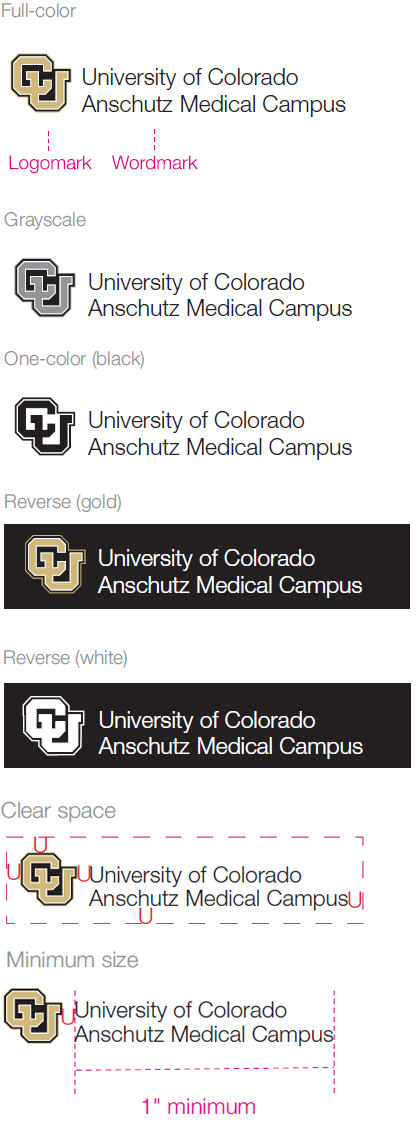
Logo signature extensions
Visual identification for all university entities—including schools, colleges, administrative units, departments, divisions, programs, events, centers and institutes—is accomplished through the use of logo signature extensions. Logo signature extensions add a wordmark-based element beneath the primary logo signature to identify the entity or unit. In all other respects, they follow the same rules for the primary logo signature. Standard horizontal, vertical and centered logo signature options will be available soon.
Using the interlocking CU alone
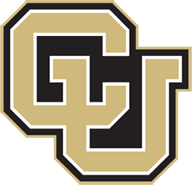
The interlocking CU should be used with the official logotype of the entity it represents.
However, there are a select set of circumstances where the logotype is not practical, or legible, and the interlocking CU may be used alone at the system level only. Campus departments must follow campus guidelines.
You may use it for the following:
- Lapel pins
- Hats
- Limited embroidery (fronts or sleeves of polo shirts and jackets, fronts of vests, etc.)
- Select promotional items (golf balls, tees, pens, etc.)
- Event banners or flags in which the full logo is hard to read from a distance
- Press backdrops
- Way-finding signs and door plates
- Large building signs
- Official systemwide programs, i.e., CU Health brand
You may not:
- Campus-specific programs or events
- a design or art element in any print or online application. Do not combine the interlocking CU with any other design elements (typography, color, imagery) to create new or different graphic treatments.
- a watermark or pattern when designing business and marketing collateral
- a stand-alone element for social media icons (though it may be used when a department, school or college name is included in the icon)
Another approved option is to combine the interlocking CU with the campus descriptor: CU Boulder, CU Denver, CU Colorado Springs, CU Anschutz Medical Campus and CU Foundation.
Any use of the official interlocking CU alone should be approved by the University Brand Identity Standards Board.
Logo usage quick reference
DO
Use the official university logo signature (or signature extension) in all university communications.
Maintain the original logo signature proportions.
Maintain the brand integrity of the logo signature.
Give the logo signature its own space.
Make sure the logo signature is easily identifiable.
Place the logo signature on clean backgrounds for maximum contrast and visibility.
DON'T
Use unofficial or third-party logos for university-related entities.
Stretch or distort the logo signature. Use the original electronic art files. Don’t redraw or retype the logo signature.
Add unofficial text or graphic elements to the logo signature.
Sandwich the logo signature or stack it with other elements.
Use the system logo where the wordmark is less than 2 inches wide.
Use colors that are not part of the approved palette.
Don’t place the logo signature on similar or low-contrast backgrounds. Avoid patterned backgrounds when possible.
Use the logo lockup as part of a text element in body copy.
Don't use the interlocking CU as a stand-alone element.
Color specifications
Color is an important part of our visual system. Specific signature colors are combined to create a unique signature for each University of Colorado campus.
To maintain consistency in our visual identity system, it is essential to reproduce our colors accurately. Always follow the CMYK, RGB and web/hex values shown on this page.
Other colors can be used in CU communications as accents in support of the primary color palette. However, all communications should feature the colors specified on this page to ensure consistency and promote the CU visual identity.
Secondary colors
Units are encouraged to be creative with CU’s official color palette (gold, black, dark gray, light gray). It should be the dominant in all applications, but units can work with campus marketing/communications offices to explore varying shades, gradient, texture and depth of the CU color palette.
The subtle use of secondary colors in digital and print publications is acceptable within limits. Units should avoid the prominent use of colors that are closely associated with other universities (eg. Green – Colorado State University; red – University of Nebraska). This does not mean those colors cannot be used, only that they should not be the dominant color.
Additional details are available in the brand identity standards for each campus.
CU Gold
C0 M10 Y48 K22
(or PANTONE® 4525 C)
R207 G184 B124
#CFB87C
Black
C0 M0 Y0 K100
R0 G0 B0
#000000
CU Dark Gray
C38 M28 Y21 K63
(or PANTONE 425 C)
R86 G90 B92
#565A5C
CU Light Gray
C16 M11 Y11 K29(or
PANTONE 422 C)
R162 G164 B163
#A2A4A3
Typography

Typography is an essential part of our personality. It helps unify our materials and promotes familiarity with our messaging.
Our typeface is Helvetica Neue, a classic sans serif face: simple, modern and elegant. The openness and geometry of its form make it highly legible. It works equally well for display type and body copy.
Helvetica Neue is recommended for use as the featured typeface in all University of Colorado communications.
Alternative fonts
In the absence of Helvetica Neue, the Arial or basic Helvetica type family are acceptable substitutes in most applications, with the Arial type family being the preferred alternative. For web design, Arial is also the preferred alternative when designing web pages and other electronic communications. Under no circumstances should any alternative fonts be used to create official CU logo lockups.
Font package
Font packages can be purchased at www.Linotype.com
Additional details are available in the brand identity standards for each campus.
Endorsement Guidelines
From time to time a vendor or other company with which CU works will ask our faculty or staff members to provide testimonial quotes for the vendor’s promotional purposes. This is prohibited under Regent Policy 14B. Endorsements can lead to misunderstandings and to misuse of CU’s name or reputation, or give a vendor an unfair advantage when competing for CU’s business.
On rare occasions, it may be in the university’s best interest to publicly testify to the qualifications of a vendor or other company or the efficacy of the vendor or other company’s products, goods, services, views or beliefs. In these cases, requests for participation by CU faculty, staff, employees or representatives must be referred to Elizabeth Collins for approval. Elizabeth will review the request and make a determination in writing. Requests should be submitted via email to Elizabeth.Collins@cu.edu
Print communications
Use university, campus and CU Foundation specific signatures, the primary color palette, and the Helvetica Neue type family in all print communications.
Cover pages are of particular importance in maintaining consistency and building the impact of the university's brand identity.
Additional details are available in the brand identity standards for each campus.

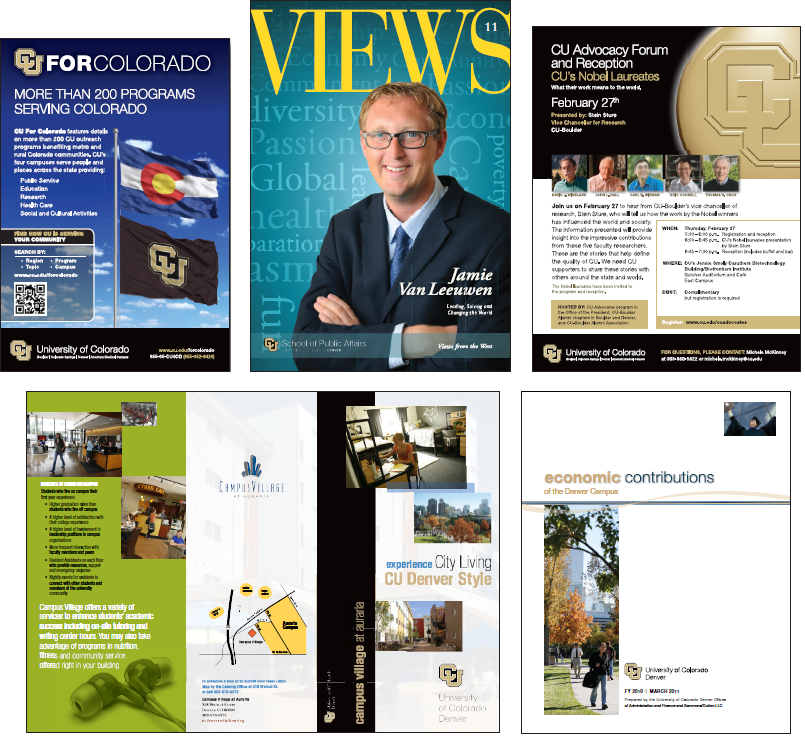
Campus references in printed materials
In all business collateral, reports, presentations and articles the first reference for each campus must be written in its entirety.
First reference:
- University of Colorado Boulder
- University of Colorado Colorado Springs
- University of Colorado Denver
- University of Colorado Anschutz
Second reference:
- CU Boulder
- UCCS
- CU Denver
- CU Anschutz
For charts and graphs (when space absolutely won’t allow for the approved second reference abbreviations):
- UCB
- UCCS
- UCD
- CU Anschutz
Brand for University of Colorado websites
Global / campus header
Content
- Web header logo identification limited to: CU Boulder, CU Denver, CU Anschutz, UCCS, CU System, CU South Denver
- School, center, unit and program identification is limited to the local / section header area
Sizing
- Overall header height (the bar) set at minimum of 50 pixels. Height can grow as needed for campuses with longer names
- CU icon height set at a minimum of 32 pixels, UCCS icon height set at a minimum 28 pixels
- Wordmark height set proportional to the logo brand standards. Top of capital letters should align with the top of the “U” in the CU icon, or standard alignment for the UCCS logo, to comply with overall brand standards.
Spacing
- Minimum of 9 pixels clear space above and below the logo (CU/UCCS icon + wordmark)
- Web header logo centered vertically in the global / campus header
- Height of logo + top & bottom clear space = height of global / campus header
Composition
- Logo arrangement preference is set at the campus level
- Option to break longer campus names across two lines
- Ability to shorten the header identification to the condensed or small-format version of campus logo (to read CU Denver, CU Boulder, etc.) at tablet and mobile browser breakpoints, to maintain accessibility while maximizing reduced content area
- Header logo may be displayed as a single image (SVG preferred), composed of both the icon and wordmark, or as an image / HTML combo, with the wordmark styled using HTML and CSS. Decision is left to each campus, as long as the overall aesthetic does not change due to the manner of display
- Background color: limited to official CU colors only: CU Black, White, CU Light Gray, CU Dark Gray or CU Gold.
- Right-side content: managed at the campus level (search box / quick links / etc.)
Local / section header
Content
- Identification of websites for CU schools, centers, units, programs and initiatives (which website is this?)
- Text-only; no logos, symbols or graphics, with the exception of named colleges & schools, or co-branded entities
- Font must comply with branding standards and be consistently applied at the major entity level (campus, system, CU Foundation); see campus brand guidelines for specifics.
- Dynamic (HTML/CSS) text only. No graphics or images for text.
Sizing
- Overall section header height (the bar) set at minimum of 90 pixels. Height should be standardized across all CU web properties.
- Primary text size: 30 pixels minimum
- Optional secondary (parent unit) text size: 14 pixels minimum, or whatever value passes web accessibility
Spacing
- Margin / padding above and below text of 30 pixels minimum.
Composition
- Background color: official CU colors only (white, light gray or dark gray.) No school or unit-specific accent colors permitted.
- Primary text styling: Neue Helvetica, or campus-approved web alternative typeface.
- Secondary text styling: Neue Helvetica, or campus-approved web alternative typeface. All caps. Standard-weight
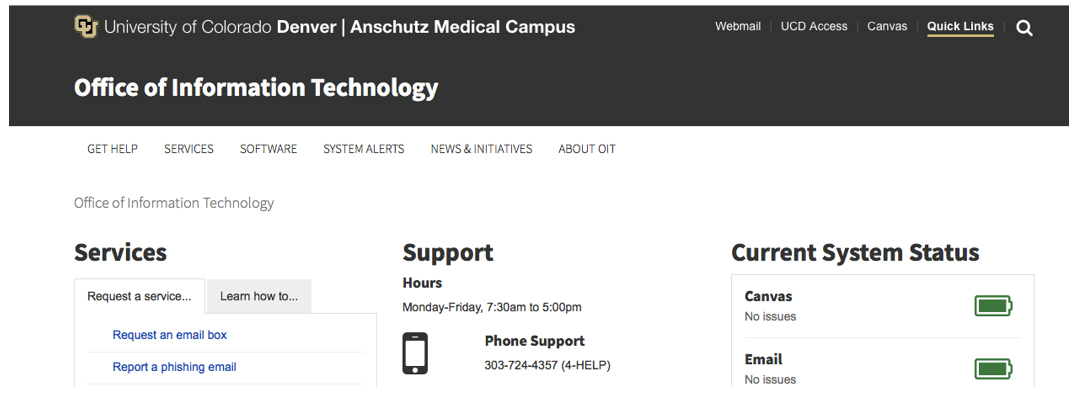

Marketing element / tagline in header
- Available to campus-wide / top-level campaign elements only. Be Boulder, CU in the city, AllFour, UCCS Fuels Success, etc.
- Approved brand mark / tagline graphic may appear in the local / section header area of webpages deemed critical to the strategic goals of each campus
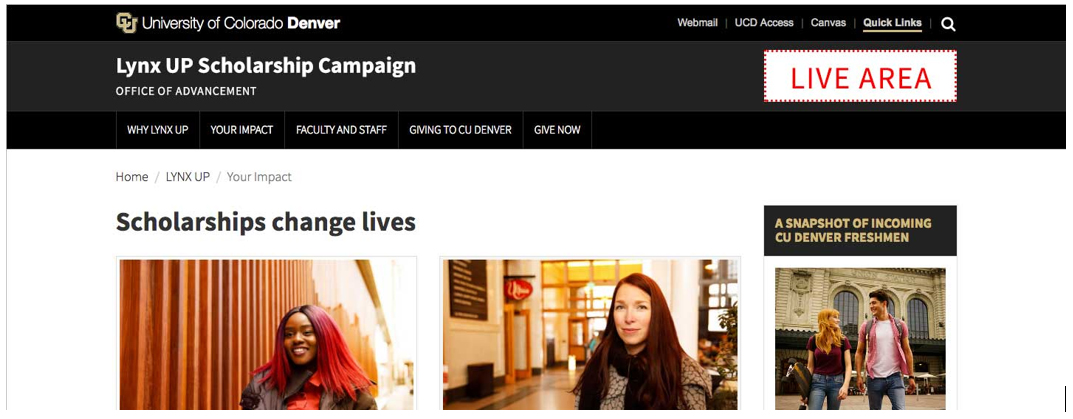
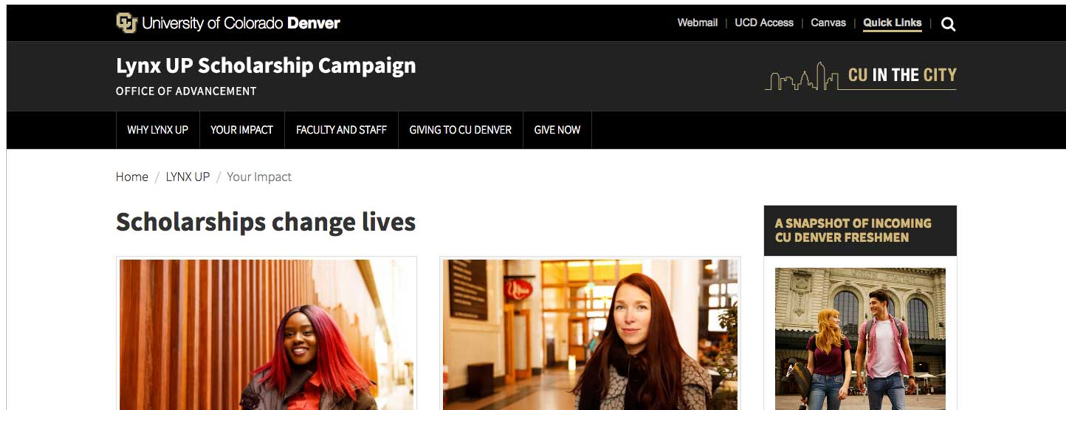
Third-party web applications
Option one (preferred): Work with the 3rd party vendor to comply with guidelines as stated.
Options two: If the third party platform isn’t capable of following the guidelines, the campus brand manager will review and approve of the following alternative:
(preferred) Use the campus logo with a headline treatment for the site name in Helvetica Neue (matching the local/section header typography standards where possible).
Use the unit-based logo signature in the top banner.
NOTE: In addition to complying with the guidelines above, all websites and web applications should clearly describe the name and site/application and it’s purpose, following web content and search engine optimization best practices.
NOTE: Procurement of third-party platforms is subject to brand review (including naming) to ensure compliance and a cohesive overall experience across the university sites and web-based applications.
Brand Website Masthead
Consistent website mastheads ensure visual consistency across University of Colorado websites, improving recognition and understanding of the university brand. The website masthead standards must be used on all official university websites. Below outlines the standards for system-wide consistency, with additional details available in the brand identity standards for each campus.
The CU website masthead is meant for university departments and university-recognized affiliates conducting official university business, and these guidelines describe the required elements for all university websites. The CU web identity may not be used on personal websites or on student group sites.
Masthead Anatomy

Examples

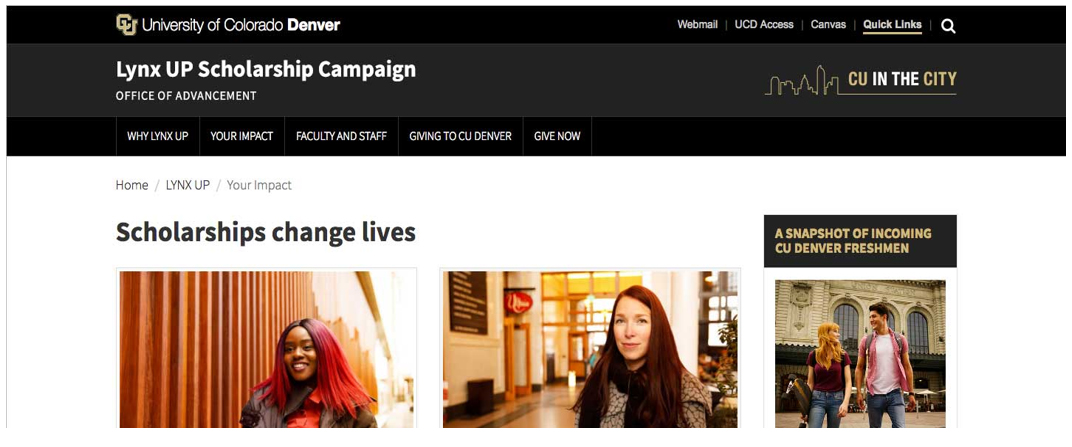

Site Navigation and Content
Standards for the website navigation and content following the masthead is managed at the campus level.
Required Footer Elements
The footer should include basic contact information including address, phone number, fax and email address (the email address can be an alias like "ContactAtCU.edu")
University name
Every website must have a link to its privacy policy in the footer
The footer should have a link to Terms of Use — www.cu.edu/terms-service
© Regents of the University of Colorado must be included in the footer
Accessibility
According to the W3C (which creates standards for the world wide web), web accessibility means that websites, tools, and technologies are designed and developed so that people with disabilities can use them. More specifically, people can: perceive, understand, navigate, and interact with all aspects of your web site. Examples of some of the steps you need to take include:
- providing captioning for videos
- making sure the site can be easily navigated using a keyboard
- using headings and spacing to group related content
- using image tagging and media alternatives
- don't use color alone to convey concepts
Providing accessible technology, resources, and information is a priority for CU and benefits everyone, not just those with disabilities. Examples, again from W3C, include:
- people using mobile phones, smart watches, smart TVs, and other devices with small screens, different input modes, etc.
- older people with changing abilities due to ageing
- people with “temporary disabilities” such as a broken arm or lost glasses
- people with “situational limitations” such as in bright sunlight or in an environment where they cannot listen to audio
- people using a slow Internet connection, or who have limited or expensive bandwidth
Additional information can be found at:
Online communications and e-communications
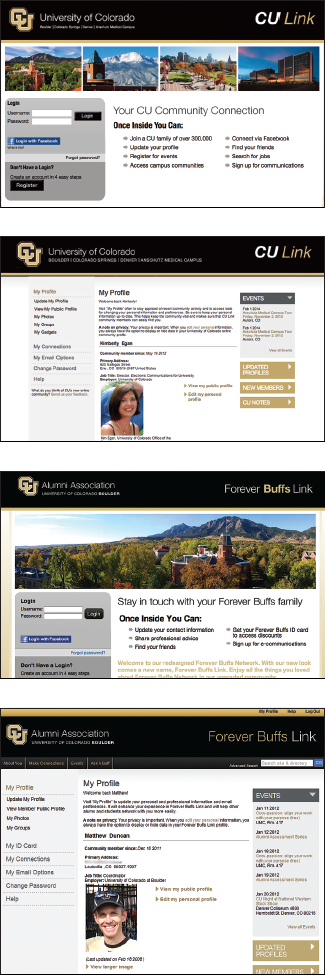
Electronic communication & online community templates
CU branded templates ensure visual consistency across all electronic communications and online communities systemwide.
Electronic communications
Brand-approved email templates can be found at http://www.cu.edu/ecomm/email-template-options. Content and images between the header and footer are up to the unit. Headers and footers must remain consistent.
A unit may choose to have a template custom designed, but it must be CU brand compliant.
All email footers must contain the following elements, all of which are found in the pre-built email templates at http://www.cu.edu/ecomm/email-template-options:
- Unsubscribe link
- Unit's contact information, including name, address, phone, website URL and email
The unit’s name must be in the header and it must be in either the Helvetica Neue or Arial font. Email templates are designed to allow a unit to customize the header within the eComm Email Marketing tool.
NOTE: All emails must be delivered via eComm to ensure compliance with federal CAN-SPAM legislation and access to accurate and up-to-date information. To request access to eComm, go to www.cu.edu/ecomm.
Online communities
If a unit wants an online community, it must work with a CU eComm campus manager for the development of the community. For system units please contact the CU system eComm program administrator at contact@cu.edu.
There are three templates to choose from for an online community.
The CU logo, name of the unit (i.e., “Alumni Association”) and the campus name are on the left side of the banner. The name of the community (i.e., “Alumni Link”) is on the right side of the banner.
The footer must contain:
- Basic unit contact information (name, address, phone, website URL, email)
- Link to Terms of Use—http://www.cu.edu/terms-service
- Link to Privacy Policy—unique to each campus
- © Regents of the University of Colorado
- Page contact or “Contact Us” link
Navigation must follow a basic structure outlined by the CU system eComm program administrator (contact@cu.edu).
Social media
Social media may be used to enhance communication, engagement, collaboration and information exchange in support the university's mission. Use common sense and thoughtful judgment when embarking on social media.
For additional information on social media for system administration please go to www.cu.edu/socialmedia.
Additional details are available in the brand identity standards for each campus.
Suggested Do's and Don'ts of Social Media
DO
Have authorization to post on your department's behalf
Protect confidential and proprietary information
Respect copyright and fair use
Ensure the security of your social media account
Be transparent
Be respectful and thoughtful
Be consistent and timely
Strive for accuracy
Place the name of the university first, i.e. on Twitter, CUMedia rather than MediaCU.
Prominently list the university on the social media site and not only the name of the department.
Use periods and underscores (_) sparingly when naming the site.
DON'T
Post private, restricted or sensitive information
Engage in arguments or negative dialogue when someone disagrees with your post
Represent your personal views as those of the university
Use the stand-alone logo of the university as your sole image
Use images that are too small to easily recognize in a browser or on mobile devices
Design your own department logo that is not recognizable as being affiliated with the University of Colorado
Use the university logo or any other university images or iconography on personal social media sites
Icons
When choosing an icon for use on social media platforms such as Facebook, Twitter and Linked In, the branded interlocking CU logo can be used as a standalone only by the Office of the President. Administrative offices within the CU system can use the interlocking CU logo with the name of the department, such as Government Relations or Payroll and Benefits Services, inscribed below the logo.
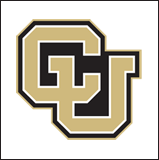
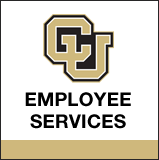
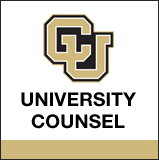
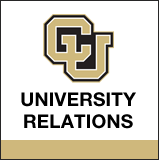
Business collateral
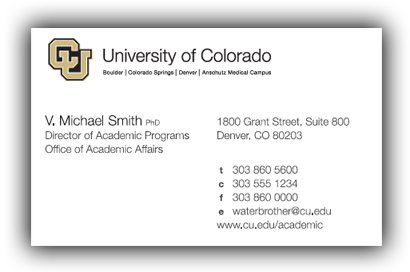
The letterhead features a signature and clean presentation of contact information. Use of a consistent layout supports our unified image and builds brand recognition.
Envelopes and business cards comply to a standard layout.
Additional details are available in the brand identity standards for each campus.

Business collateral should contain only essential information as articulated in system and campus identity standards manuals. Business cards and stationery should not have extraneous information such as taglines, additional contact information, or departmental or individual mission statements (either on front or back of business cards). The only acceptable use for the back of business cards is essential information such as physician clinic or medical/emergency contact numbers. QR codes may be added to the back of business cards only if they contain university contact information and/or point to official university websites with the domain name of cu.edu, Colorado.edu, uccs.edu, ucdenver.edu or cufund.org.
Stationery/envelopes
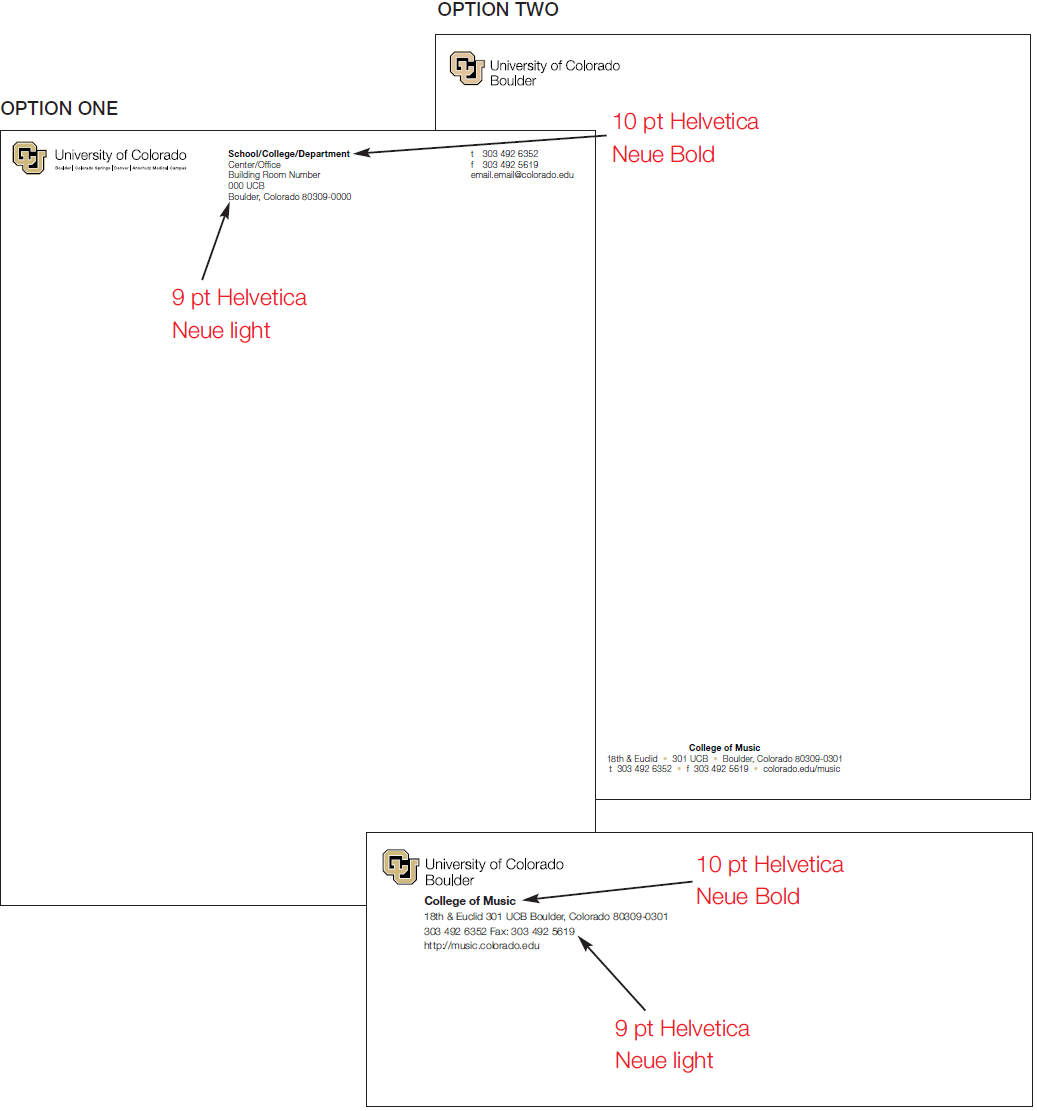
Exterior and Interior Signage Standards
University of Colorado Exterior and Interior Signage Standards
as an Addendum to APS 2025: University Brand Identity and Logo Usage
I. Purpose
A. These standards have been developed to assist campus architects, facilities personnel, communicators and sign designers in developing consistent signage on and among the campuses of the University of Colorado while maintaining the unique character found at each. The standards describe the elements of signage so as to communicate the consistent brand message, along with acceptable elements that connote the image of the campus.
B. Definitions
1. Terminology will be used in this document to define specific signage elements and usage.
University logomark, wordmark and signature are defined as follows: The university logomark is the graphic mark, the interlocking CU.
The university wordmark is the verbiage used, i.e. University of Colorado. The university system signature is the logomark with the wordmark, as shown below: The campus signature is the logomark with the wordmark plus the campus name as shown below:





C. Existing Signage
1. Existing signs that do not meet current brand standards shall be grandfathered until a building remodel is undertaken and/or signs are in poor repair and must be replaced. In each case, new signs shall comply with these sign standards.
II. General
A. All words, logos and marks used on campus signage shall conform to the University of Colorado Identity Standards, latest edition.
1. On-campus institutional partners shall adhere to these standards with the exception that they may include their campus signature, in lieu of that of the University of Colorado, within designated districts of operation (as defined by each campus) for Identity (See Section IV) and Building Identification (See Section V) signage conditions. Additionally, off-campus affiliates using university marks should adhere to these standards.
B. Materials and treatment for all signage also shall conform to University of Colorado Signage Standards as published by each campus. See Addendum IV for links specific to each campus.
C. Approvals:
- Campus exterior signage shall be subject to review by university’s Design Review Board as required by APS 3002, Capital Construction Planning and Projects, Appendix 3: https://www.cu.edu/ope/aps/3002
- Use of the university logomark, wordmark or signatures is subject to review by the Brand Identity Standards Committee.
III. Gateway Signage
A. Definition: Gateway signage is defined as elements that comprise a monument-scale definition of a campus boundary, generally located at a major entrance or corner of the campus property that is visually prominent to the community.
B. Scale: Gateway signage is generally scaled for moving vehicular traffic, although may also contain elements that are scaled for pedestrians or bicycles. Refer to USSC (United States Sign Council) for size, height & legibility guidelines: https://usscfoundation.org/wp-content/uploads/2018/03/USSC-Guideline-Sta...
C: Signage Elements: Official entrances and gateways to each campus shall use the interlocking CU logo with the signature for the campus. Where the design of the gateway sign allows, the university seal may be used as a separate visual element from the logo/wordmark.
D. Materials:
- Gateway signage shall be constructed of stone walls, brick walls and other materials consistent with that used in building construction for the campus property on which the gateway sign is to be located.
- Landforms, features and landscaping should be used to enhance the gateway signage and give prominence appropriate to the role of the gateway.
E. Lighting: Gateway signage shall be lighted using ground lighting, back lighting or direct lighting as appropriate for the design of the signage feature and consistent with the LEED / sustainability objectives for the campus.
IV. University Identity Signage
A. Definition: University identity signage is signage used to call individual buildings out from surrounding buildings that are not part of the University of Colorado. Signage is typically located within the top half of a building’s facade. University identity signage shall be limited to no more than two of a building’s facades unless otherwise approved by the Design Review Board.
B. Scale: University identity signage is generally scaled for moving vehicular traffic. Refer to USSC (United States Sign Council) for size, height & legibility Guidelines: https://usscfoundation.org/wp-content/uploads/2018/03/USSC-Guideline-Sta...
C. Signage Elements: University identity signage shall use the signature of the campus it is denoting. Sub-identities for donor-named schools or colleges shall not be used as university identity signage.
D. Materials: Subject to review and approval by the Design Review Board.
E. Lighting: Identity signage shall be illuminated where possible and may use internal lighting consistent with LEED / sustainability objectives for the campus.
Public Private Partnership Signage
The University of Colorado will occasionally engage in public-private partnerships with organizations in which an external organization shares, leases or provides financial support for buildings and their operations that are (or will be) built on campuses or land the university owns. If the external organization leases or provides funding for more than 35 percent of the gross square footage of the facility, it is entitled to exterior building, wayfinding and monument signage in conjunction with CU signage and in keeping with its sign standards. The president and campus chancellors have discretion about specific details around gross square footage and/or funding provided.
In these public-private partnerships, the university shall enter into an MOU with the organization to ensure signs adhere to university sign standards. The MOU would further ensure that the university has the ability to remove the name if the organization does not honor its financial commitments or if the reputation of the organization has a negative impact on the university.
V. Building Identification Signage
A. Definition: Building identification signage consists of signs mounted near building entrances that are generally mounted on pedestal or ground-based enclosures but may be mounted on the face of a building, typically when located within urban campus environments. The purpose of the sign is to announce the name of the building to assist a person seeking the building. Face-mounted building signage should be located at a building’s primary entrance as permitted by campus design guidelines.
B. Scale: Building identification signage should be scaled for pedestrians and bicycle users. Buildings located within urban environments may require signage scaled for vehicular speed-appropriate legibility. Signs can be located further up on a building but must include the university icon.
C. Signage Elements:
- The campus signature may be located at the top 25% of the building identification signage.
- Text of building identification signage shall be in Helvetica Neue Medium or Bold of a size not more than 100% larger than the full mark.
- A sub-text may be included on the sign to identify special status of a building. If included, sub-text shall be limited to 67% of the main text and shall use both upper and lowercase letters.
- Donor-named schools, colleges or buildings shall conform to approved typeface and identity standards within campus design guidelines as approved by the Design Review Board.
- Signage text and graphics should be left justified.
D. Materials – Pedestal or Ground-Based Enclosures:
- Materials that support building identification signage shall be from the vocabulary of materials in the approved design guidelines for each campus.
- Building identification signage shall have a background color that conforms to one of the university color specifications.
- Exception: Background colors that are part of an approved comprehensive signage system shall be limited to the color palette approved for the system.
- Exceptions: CU-Boulder shall be allowed a terra cotta background matching the campus vocabulary; UCCS shall be allowed a dark brown background matching the campus vocabulary.
- Open space equal to the height of the text shall be given both above and below the main text, and open space equal to or greater than the height of any sub-text shall be given surrounding the sub-text.
- Where dark background colors are used (terra cotta, black, dark brown or dark grey), the one-color, full mark shall be used with appropriate contrast, following reverse specifications.
E. Materials – Face-Mounted Signage:
- Materials that support face-mounted building identification signage shall be from the vocabulary of materials in the approved design guidelines for each campus.
F. Lighting: Building Identification Signage may be illuminated either internally or by ground-mounted lighting consistent with LEED/sustainability objectives for the campus. Where no lighting is provided, signage should be located near existing street lighting or nearby lighting.
VI. Vehicular Directional Signage
A. Definition: Vehicular directional signage is defined as signage used to direct a person in a vehicle to a parking lot or building that is or is near their likely destination.
B. Scale: Vehicular Directional Signage shall be scaled for moving vehicles at the posted speed limit. Refer to USSC (United States Sign Council) for size, height & legibility guidelines: https://usscfoundation.org/wp-content/uploads/2018/03/USSC-Guideline-Sta...
C. Signage Elements:
- The campus signature shall be located at the top of vehicular directional signage.
- Text of vehicular directional signage shall be in Helvetica Neue Medium or Bold of a size not more than 50% larger than the full mark. 3. Where dark background colors are used (black, dark brown or dark grey), the onecolor, reverse full mark shall be used.
- Approved co-branding graphic logos of campus partnering institutions may be included.
- Campus approved graphic logos for the routing of ambulances, locating of emergency departments, hospitals, parking and delivery may be included along with their associated color palettes. See Addendum III for examples specific to each campus.
D. Materials:
- Materials that support vehicular directional signage shall be from the vocabulary of materials in the approved design guidelines for each campus.
- Directional signage within the public right-of-way shall conform to the U.S. Department of Transportation Federal Highway Administration Manual of Uniform Traffic Control Devices, latest edition.
- Directional signage on university streets shall have a background color that conforms with one of the university color specifications.
- Exception: Background colors that are part of an approved comprehensive signage system shall be limited to the color palette approved for the system.
E. Lighting: Vehicular directional signage shall be lighted or use highway reflective (retroreflective) coatings.
VII. Pedestrian Directional Signage
A. Definition: Pedestrian directional signage consists of directional signage, maps, information kiosks and other elements that direct a person from their point of arrival to their destination.
B. Scale: Pedestrian directional signage is scaled for pedestrians and bicycle users.
C. Signage Elements:
- The campus signature shall be prominently located on all pedestrian directional signage throughout the campus.
- Text of pedestrian directional signage shall be in Helvetica Neue Medium or Bold of a size not more than 50% larger than the full mark.
- Where maps or other graphic devices are used, the logo should be prominently displayed.
- Signage text and graphics are left justified.
D. Materials:
- Materials that support pedestrian directional signage shall be from the vocabulary of materials in the approved design guidelines for each campus.
- Pedestrian directional signage shall have a background color that conforms to one of the university color specifications.
- Exception: Background colors that are part of an approved campus comprehensive signage system shall be limited to the color palette approved for the system.
- Letters identifying pedestrian directional displays (information kiosks, campus directories or maps) may be of raised metallic letters.
- Where dark background colors are used (terra cotta, black or dark grey), the reverse full mark shall be used.
E. Lighting: Pedestrian directional signage should be illuminated (internally or externally) for ease of travel at night.
VIII. Regulatory Signage
A. Definition: Regulatory signage is used to inform the public about what they must or should do (or not do) under a given set of circumstances. Other types may be signs located on streets and in parking areas having to do with parking, signs in public places or signs in architectural facilities prohibiting specific types of activities. They are broadly used to indicate or enforce laws and regulations adopted by the university.
B. Scale: Regulatory signs should be scaled for the primary users, be it vehicular, bicyclist or pedestrian.
C. Signage elements:
- Traffic regulatory signage shall conform to the U.S. Department of Transportation, Federal Highway Administration Manual of Uniform Traffic Control Devices, latest edition.
- Text of non-traffic regulatory signs shall be in Helvetica Neue Medium or Bold.
D. Materials:
- Materials that support regulatory signage shall be from the vocabulary of materials in the approved design guidelines for each campus.
E. Lighting: Regulatory signage should not be lighted. Regulatory signage should use highway reflective (retro-reflective) coatings.
IX. Interior Entrance Lobby Signage
A. Definition: Interior entrance lobby signage is placed at the entrance of a building or to a college, school or department. It is used to establish a first impression of that building, college, school or department. They are generally welcoming in nature rather than informational. The use of interior entrance lobby signage is discretionary and should follow consistent interior signage guidelines.
B. Scale: Interior entrance lobby signage is pedestrian in scale.
C. Signage Elements:
- The wordmark is optional, however the use of the wordmark is preferable.
- Text of interior entrance lobby signage shall be in Helvetica Neue Medium or Bold of a size not more than 100% larger than the full wordmark.
- A sub-text may be included on the sign to identify special status of a building. If included, sub-text shall be limited to 67% of the main text and shall use upper and lowercase letters.
- Signage text and graphics are preferred left-justified.
- Donor-named schools or colleges may use approved typeface and identity standards.
- Institutes with approved co-branding graphics may be used.
- Where other graphics, ornamentation or other visual devices are provided, signage shall be located so as not to compete with the other graphics, ornamentation or other visual devices.
D. Materials:
- Materials used in interior entrance lobby signage should be of any approved material with color properties allowed in the University of Colorado Identity Standards, latest edition.
- Building entrance lobby signage should have a background color that conforms to one of the university color specifications.
- Exception: Background colors that are part of an approved comprehensive signage system shall be limited to the color palette approved for the system.
- Exception: Donor-named schools or colleges and institutes with approved cobranding graphics may use the approved alternatives.
- Exception: Signs with dimensional letters that are attached directly to the wall.
- Open space equal to the height of the text shall be given both above and below the main text, and open space equal to or greater than the height of any sub-text shall be given surrounding the sub-text.
- Where dark background colors are used (black, dark brown or dark grey), the one color, reverse full mark shall be used.
E. Lighting: Interior entrance lobby signage may be lighted.
X. Room Identification Signage
A. Definition: Room identity signage shall comply with CU Brand Standards. Additional optional signage shall be approved by campus brand manager and campus architect.
XI. Building Directories
A. Definition: Building directories are fixed signs that identify the building name and occupants. They are generally located at building entrances and lobbies in a prominent location that is easily accessible. For purposes of this section, electronic directories are excluded.
B. Scale: Building directories are pedestrian in scale.
C. Signage Elements:
- Text of building directories shall be in Helvetica Neue Medium or Bold of a size not more than 75% larger than the full mark. The complete building name shall be given in all uppercase letters at the top of the directory.
- Directory information shall be included on the sign to identify programs offices, or departments as necessary to fully communicate the location of the building occupant.
- Signage text and graphics shall be left justified in three columns or fewer.
- Donor-named schools or colleges may use approved typeface and identity standards.
- Institutes with approved co-branding graphics may use approved alternatives.
- Where other graphics, ornamentation or other visual device are provided, signage shall be located so as not to compete with the other graphics, ornamentation, or other visual device.
D. Materials:
- Materials used in building directories shall be of an approved material with color properties allowed in the University of Colorado Identity Standards, latest edition, and shall match interior building entrance signage, if provided.
- Building directories shall have a background color that conforms to one of the university color specifications.
- Exception: Background colors that are part of an approved comprehensive signage system shall be limited to the color palette approved for the system.
- The proportions of the building directories shall be as required to provide a concise description of the building occupant location.
4. Open space equal to the height of the text shall be given both above and below the main text, and open space equal to or greater than the height of any sub-text shall be given surrounding the sub-text.
5. Where dark background colors are used (black, dark brown or dark grey), the one color, reverse full mark shall be used.
XII. Donor Recognition Interior and Exterior Signage
A. Definition: Donor signage is handled on a campus by campus basis.
B. Each campus shall develop its own process and adhere to the CU Brand Identity Standards, as outlined: http://www.cu.edu/brand
C. See Addendum I for review, approval and suggested steps for development.
XIII. Congratulatory Interior and Exterior Signage
A. Definition: Congratulatory signage is handled on a campus by campus basis.
B. Each campus shall develop its own process and adhere to the CU Brand Identity Standards, as outlined: http://www.cu.edu/brand
C. See Addendum II for review, approval and suggested steps for development.
XIV. Administrative Policy Statement
A. Definition: Each campus will have supplemental guidelines and an approval process.
B. These sign standards are an addendum to the university brand policy statement, http://www.cu.edu/ope/aps/2025
Addendum I
Donor Recognition Interior and Exterior Signage
Donor signage could be handled on a campus by campus basis. Each campus shall develop own process and adhere to the CU Brand Identity Standards, as outlined: https://www.cu.edu/brand.
A. Review and approval of interior donor recognition signage
Since process varies from campus to campus, the following process is recommended to ensure consistency and clarity of how interior donor signage will be handled. Based upon the information provided by each campus, it’s suggested that the following individuals should be involved in the process:
- Involved in developing the recommendation
- Campus architect
- Campus brand manager
- Campus advancement VP and appropriate unit development officer
- Facilities representative, institutional planning or management lead
- Review and approve the recommendation
- Chancellor
- Dean associated with the building project
- Others at campus leadership’s discretion
B. Suggested steps for interior signage development:
- A plan that defines naming opportunities, levels and costs will be first approved by the chancellor and dean associated with the project and then submitted to the campus architect, the building committee responsible for the project and the campus brand manager at the front end of any project that has donor recognition signage involved. (Input and suggestions regarding space preferences for signage that ensure maximum visibility and adequate space given the naming opportunities available could be provided at this time).
- Request that the campus/building architect develop a donor signage plan that includes location, space and placement of donor recognition signage and specifications of size, layout, materials, color, format and costs.
- Review options with the building committee, revise as needed, and approve plan.
- Advancement Officer communicates signage plan specifics to appropriate parties within CUF and CU.
- Advancement Officer serves as the point person for signage requests and is responsible for ensuring accuracy of donor names/levels/signage content.
Important Note: Discussions with donors about recognition possibilities on interior (or exterior) building space should not be started until a recommendation on donor recognition has been developed and approved as stated above.
C. Naming Rights/Sponsorships
Agreements negotiated for naming rights or sponsorships shall follow university building identity standards. Corporate logos shall not be permitted on primary exterior signage on University of Colorado buildings. Signs on donor-named buildings shall conform with university sign standards and shall not be placed on the upper portion of a building, unless that building is in an urban setting and/or is on the periphery of a campus, not the interior.
Addendum II
Congratulatory Interior and Exterior Signage
Congratulatory signage can be handled on a campus by campus basis. Each campus shall develop its own process and adhere to the CU Brand Identity Standards, as outlined: https://www.cu.edu/brand.
A. Review and approval of interior and exterior congratulatory signage Since process varies from campus to campus, the following process is recommended to ensure consistency and clarity of how interior congratulatory signage will be handled.
Based upon the information provided by each campus, it’s suggested that the following individuals should be involved in the process:
- Involved in developing the recommendation
- Campus architect
- Campus brand manager
- Department representative proposing congratulatory signage
- Facilities representative, institutional planning or management lead (will vary by campus)
- Review and approve the recommendation
- Chancellor
- Dean associated with the building project
- Others at campus leadership’s discretion
B. Suggested steps for congratulatory signage development:
- A plan that defines the proposed congratulatory signage including a mock-up of its design, estimated costs and sources of funding will be first approved by the chancellor and dean/VC associated with the project and then submitted to the campus architect, the building committee responsible for the project and the campus brand manager at the front end. (Input and suggestions regarding space preferences for signage that ensure maximum visibility and adequate space given the proposed location and scale of the signage will be provided at this time).
- Review plan with any donors involved, in consultation with the Office of University Advancement, as appropriate, and approve final designs, costs and funding.
- Review the final plan with the building committee, revise as needed, and approve plan.
Addendum III
CU Anschutz Medical Campus - Signage Standards Key CU Anschutz Medical Campus
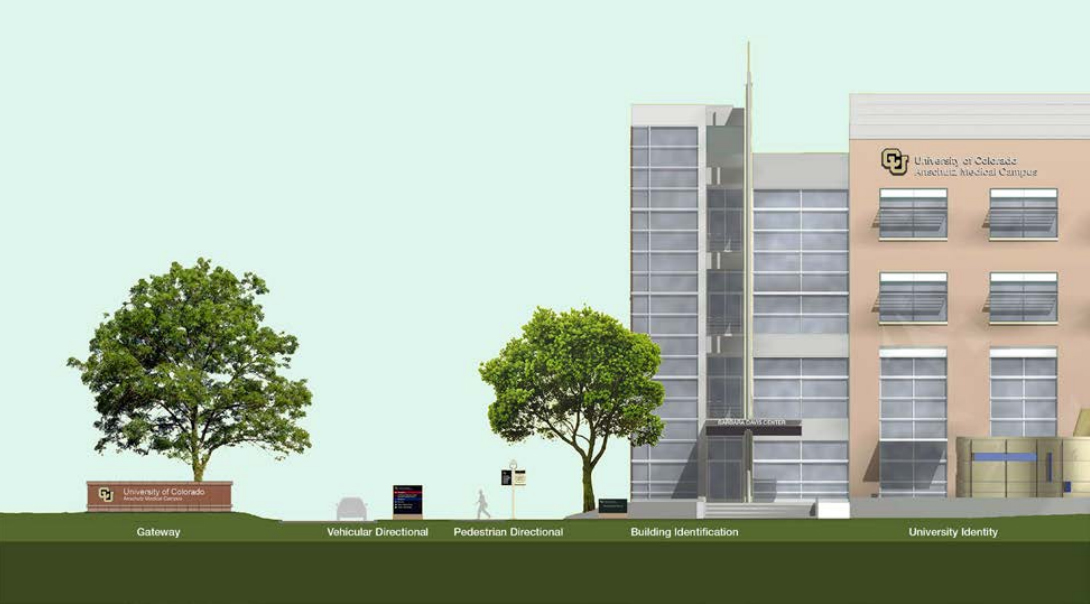
CU Anschutz Medical Campus Vehicular and Pedestrian Directional Signage
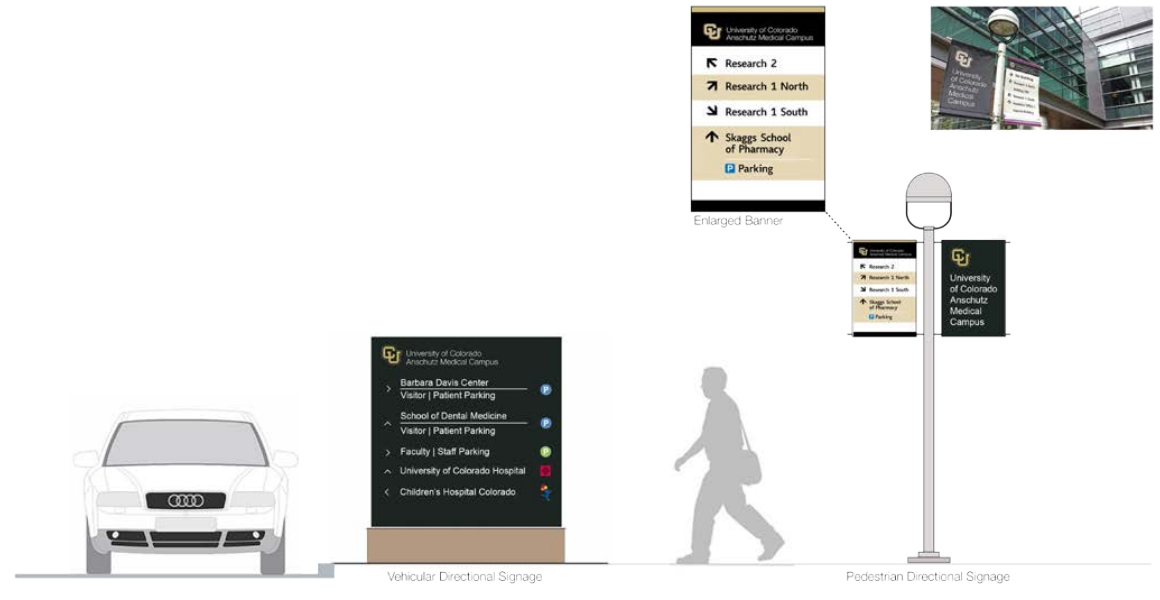
UCCS – Building Identification on Canopy

UCCS – Interior Directional Signage
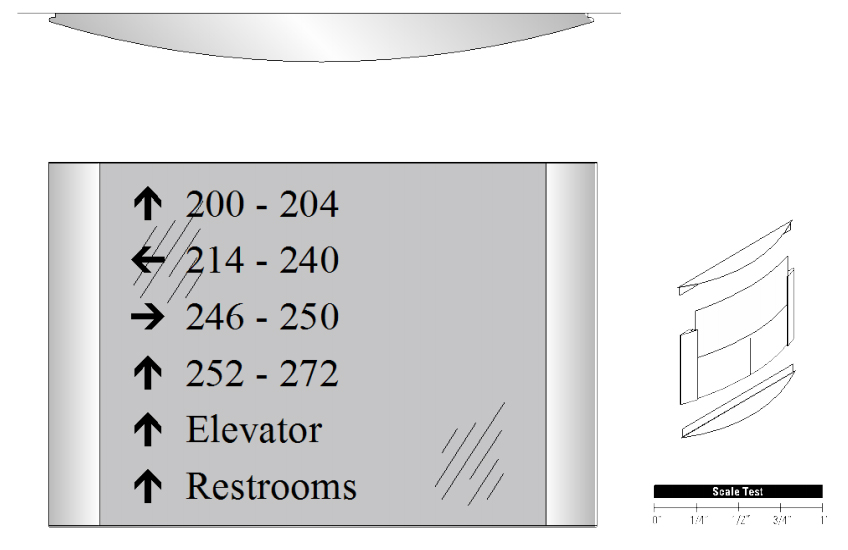
UCCS – Free Standing Building Identification Sign

UCCS – Pedestrian Directional Signage
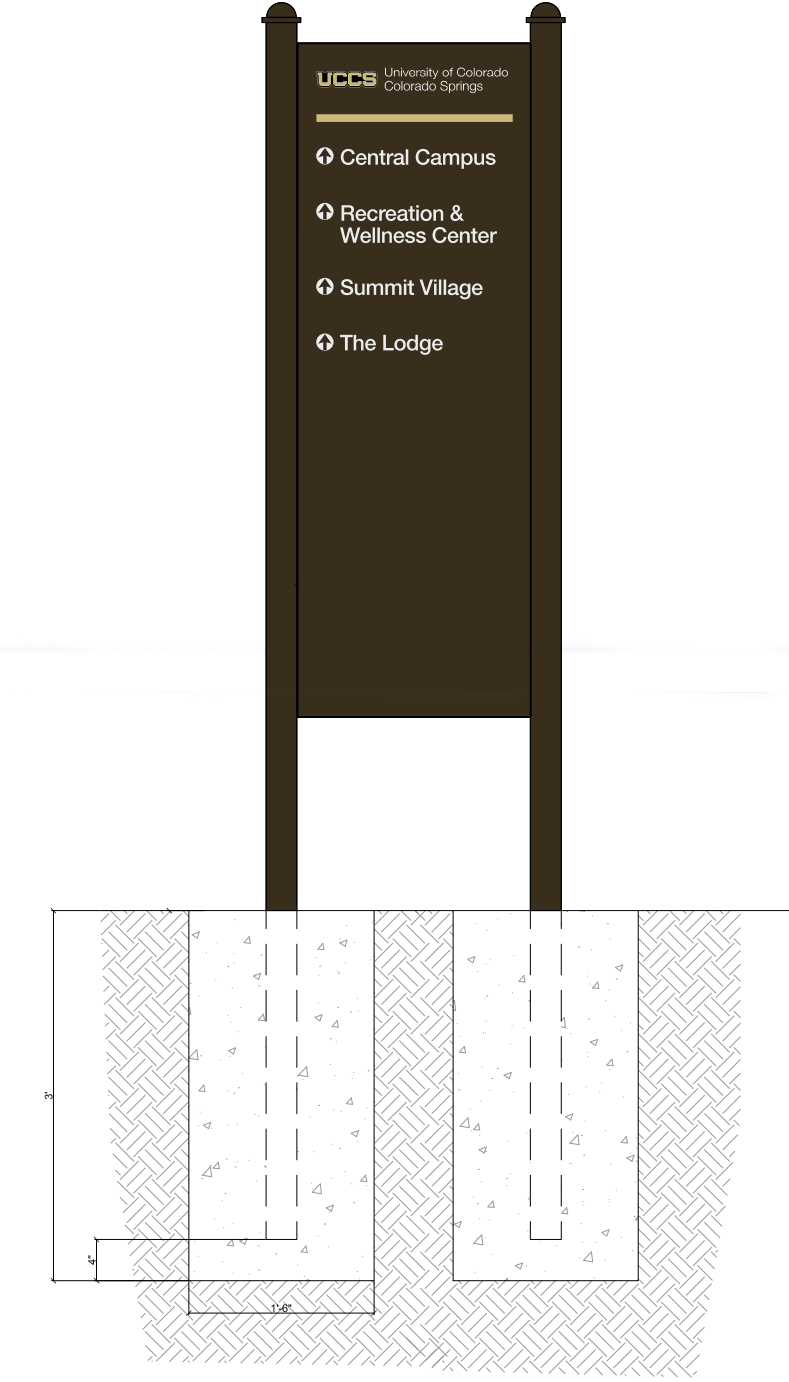
CU Boulder - Signage Standards
CU Boulder - Gateway Signage

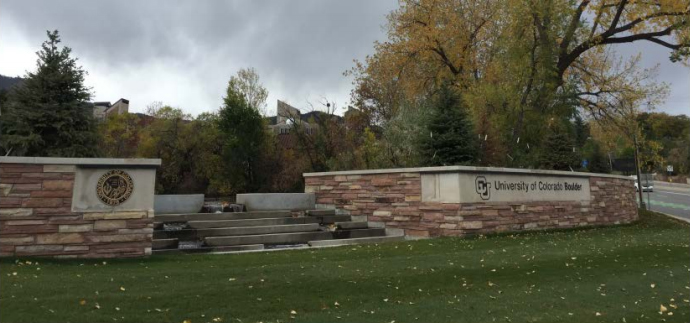
CU Boulder - Building Identification Signage
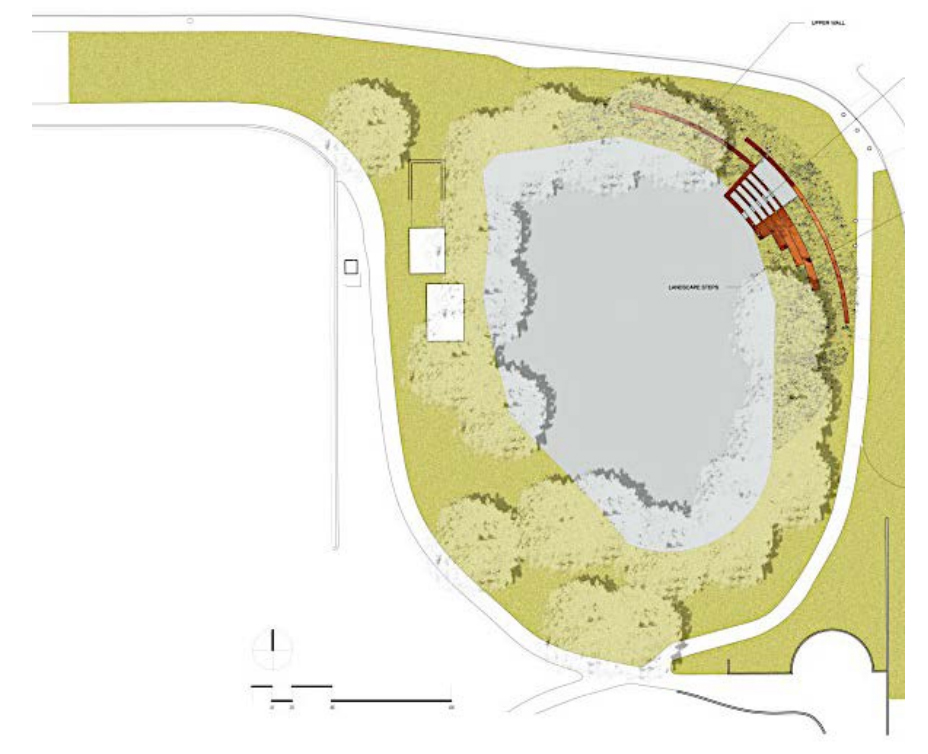
Addendum IV Campus Sign Standards
-
UCCS
http://www.uccs.edu/Documents/facsrvs/campus%20design%20guidelines%2007.pdf -
CU Denver | Anschutz Medical Campus
http://www.ucdenver.edu/about/departments/FacilitiesManagement/Facilitie...
Email signatures
Email signatures should be done as shown here. System employees may download the email signature template from the branding website.
- Text size should be 10pt, Arial (Helvetica, san-serif).
- Text color should be black.
- Please keep the campuses legible and crisp.
- If your department has official CU social media accounts (i.e. Facebook, Twitter, etc.) you may add the social media icons below the system logo.
System administration example:
Name
Title, Department
University of Colorado
1800 Grant Street, Suite 000
Denver, CO 80203
t 303 860 0000
c 303 555 0000
f 303 860 0000
www.cu.edu

Board of Regents example (to be used by the board and board staff only):
Name
Title, Department
University of Colorado
1800 Grant Street, Suite 000
Denver, CO 80203
t 303 860 0000
c 303 555 0000
f 303 860 0000
www.cu.edu/regents

Apparel
Departments and units whose personnel wear apparel as part of their job duties (with the exception of University Police) should use the university logomark and wordmark on apparel. The preferred use is full-color
or one-color. When using one color it must be black, white or gold.
When embroidering the system logo, you do not need to include the campus name as part of the signature. When embroidering hats you may separate the interlocking CU from the “University of Colorado.” Both must still appear on the hat but you can have the interlocking CU on the front and “University of Colorado” on the back.
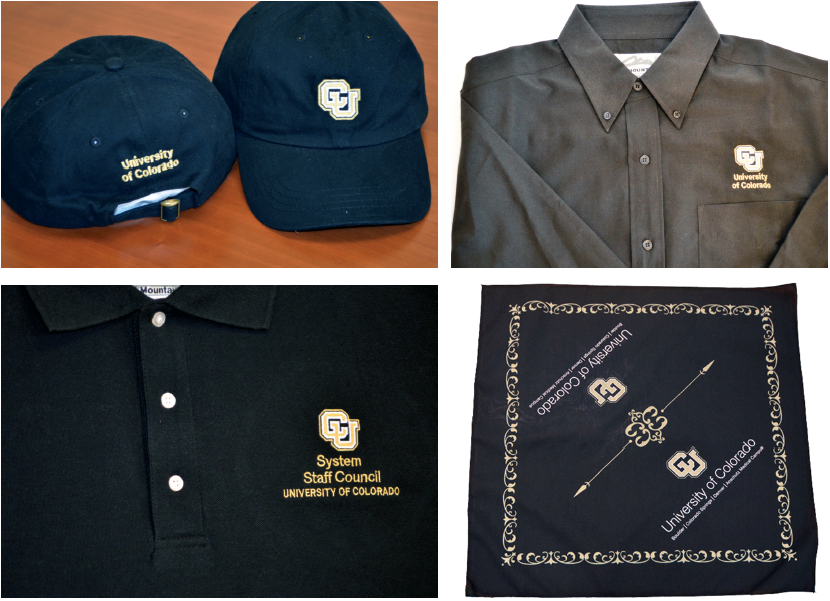
Promotional items
The system logo must include the campuses on most promotional items. The exception to the rule is when the printing surface is too small to clearly print the campus line. For example, pens can be printed with only the logo mark and University of Colorado. You must receive approval from the Brand Identity Standards Board to print the system logo without the campuses. When printing a one-color logo it must be in black, white or our Pantone® gold (4525 C).
